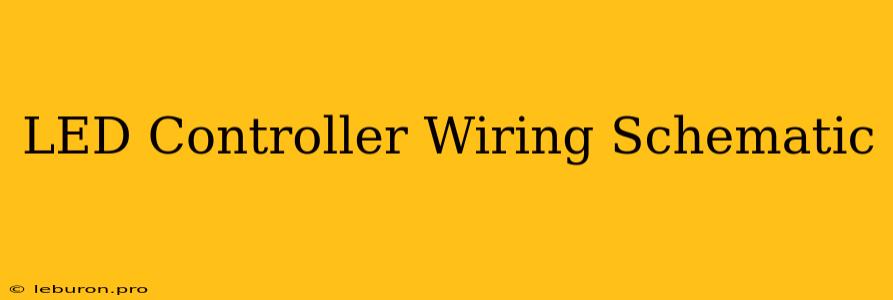Navigating the Labyrinth of LED Controller Wiring Schematics
Understanding how to properly wire an LED controller is crucial for any lighting project, whether it's a simple accent strip or a complex multi-zone system. However, deciphering the often-complex wiring schematics provided with LED controllers can feel like navigating a labyrinth. This guide aims to demystify the process, equipping you with the knowledge to confidently connect your LED controller and bring your lighting vision to life.
Understanding the Basics: Key Components and Their Roles
Before diving into specific wiring diagrams, let's establish a foundational understanding of the essential components involved in an LED controller system.
1. The LED Controller: The Brain of the Operation
At the heart of the system lies the LED controller, acting as the control center. It receives input signals from various sources (like a remote control, a smartphone app, or a dimmer switch) and translates these instructions into electrical signals that dictate the behavior of your LED strips.
2. Power Supply: Providing the Fuel
The power supply, often a dedicated unit separate from the controller, converts household AC power (120V or 240V) into a lower, safer DC voltage (typically 12V or 24V) suitable for powering your LED strips.
3. LED Strips: The Illuminating Elements
The LED strips themselves are the final output, converting electrical energy into light. They come in various lengths, colors, and configurations, offering a wealth of creative possibilities for your project.
Deciphering LED Controller Wiring Schematics: A Step-by-Step Approach
Now that we understand the core players, let's break down the process of interpreting LED controller wiring schematics.
1. Identify the Components: A Visual Checklist
The first step involves identifying the key components on the schematic. Look for clear depictions of:
- The LED Controller: It will be labeled with its model number and may be represented by a box or symbol.
- Power Supply: This unit will also be labeled and might be represented by a power symbol or a transformer symbol.
- LED Strips: Look for lines or symbols representing your LED strips, with clear indications of their positive (+) and negative (-) terminals.
- Connectors: These are the points where the wires connect to different components, often labeled with letters or numbers.
2. Trace the Flow of Power: Following the Circuit
Once you've identified the components, the next step is to trace the flow of power through the circuit. This involves understanding the relationships between the components.
- Power Supply Output: Find the positive (+) and negative (-) outputs of the power supply. These terminals should be clearly labeled on the schematic.
- Controller Input: The schematic should show the power supply's outputs connecting to the controller's input terminals. These are usually labeled "IN" or "PWR" with a plus and minus symbol.
- Controller Output: Locate the controller's output terminals, often labeled "OUT" or "LED" with plus and minus symbols.
- LED Strips: The controller's outputs connect to the LED strips' positive (+) and negative (-) terminals.
3. Understanding Terminal Connections: Matching the Pins
The wiring schematic will also illustrate the specific connections between the components. This is where understanding terminal numbers and labels becomes crucial.
- Pin Numbers: Many schematics use pin numbers to clearly designate each terminal on the controller and power supply. These numbers should be clearly indicated.
- Terminal Labeling: Other schematics use letters or symbols to label the terminals. Common labels include "V+", "V-", "GND," "COM," "R," "G," and "B."
4. Common Wiring Configurations: Adapting to Different Setups
While the basic principles remain constant, LED controller wiring schematics can vary based on the type of controller and the desired lighting setup. Here are a few common configurations:
- Single Channel: This configuration uses a single output channel from the controller to power a single LED strip.
- Multi-Channel: This setup allows for controlling multiple LED strips independently. The schematic will show separate output channels for each strip.
- RGB (Red, Green, Blue): This configuration uses three separate output channels to control the red, green, and blue LEDs within each strip. The schematic will show three separate output channels labeled "R," "G," and "B."
- RGBW (Red, Green, Blue, White): This setup adds a fourth channel to control white LEDs, offering more color temperature flexibility. The schematic will show four output channels labeled "R," "G," "B," and "W."
5. Troubleshooting: Identifying Potential Issues
Even with a clear understanding of the schematic, you might encounter issues during the wiring process. Here are some common troubleshooting tips:
- Check for Loose Connections: Ensure all wires are securely connected to the correct terminals.
- Double-Check Polarity: Make sure the positive (+) and negative (-) terminals are properly aligned.
- Verify Power Supply Compatibility: Confirm that the power supply is rated for the voltage and amperage required by your LED strips.
- Check for Short Circuits: Inspect the wiring for any accidental contact between wires that could create a short circuit.
Conclusion: Demystifying LED Controller Wiring Schematics
By mastering the basics of LED controller wiring schematics, you'll be able to tackle any lighting project with confidence. Remember to approach the process systematically, starting with component identification, tracing power flow, and understanding terminal connections.
While these schematics might initially seem daunting, they are essential tools for ensuring proper installation, optimal performance, and a truly stunning lighting experience. Armed with this knowledge, you'll be able to navigate the world of LED controller wiring schematics with ease and bring your lighting vision to life.
